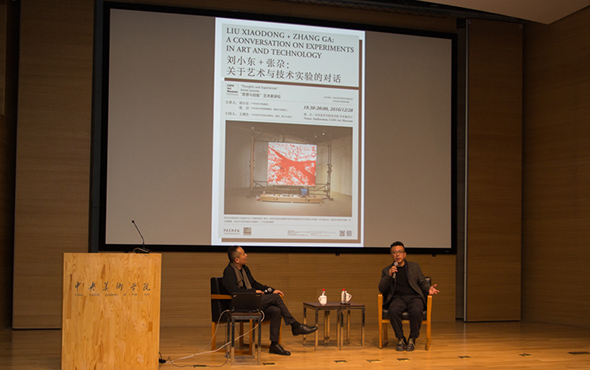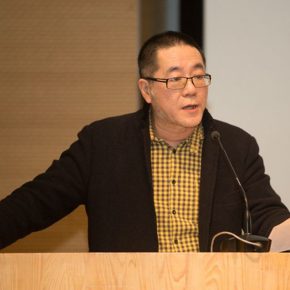
On the evening of December 28, 2016, the lecture entitled “Liu Xiaodong + Zhang Ga: A Conversation on Experiments in Art and Technology” was held in the Auditorium of CAFA Art Museum. This lecture was hosted by the Director of CAFA Art Museum Wang Huangsheng, the artist Liu Xiaodong and curator Zhang Ga were invited to participate in a discussion on new media art and Liu Xiaodong’s new work entitled “The Weight of Insomnia” with a conversation.
At the beginning of the lecture, the moderator Wang Huangsheng introduced the guests to the audience and talked about the “A&T@” project launched by the famous media art curator Prof. Zhang Ga in 2015, the project is for the exploration of the problems related to new media art, committed to finding new possibilities and methods for the combination of art and technology. It should be noted that Zhang Ga’s project does not start from emphasizing technology as art, but starts from the art itself, combined with technology to break the possibilities of art in contemporary times. Taken as the background, Zhang Ga collaborated with the artist Liu Xiaodong on this project, Liu’s latest work “The Weight of Insomnia” became the result of the first phase born under the framework of “A&T@” project, it is currently on shown at the “Datumsoria” exhibition in Chronus Art Center (CAC), and Zhang Ga serves as the curator.
The “Weight of Insomnia” consists of three huge canvases which are respectively set in architectural scaffolding. Three brushes are respectively controlled by three mechanical arms to continually “create” on the three canvases and the brushes interpret the discontinuous live-streamed data captured by the camera and depicted on the canvas, presenting the changing landscapes of three places including Shanghai Bund, Beijing Sanlitun and Jincheng Plaza in Liaoning, tracked and photographed by the camera.
At the origin of the “A&T@” project, Prof. Zhang Ga first mentioned that the sensitivity of the artist to new things makes the motivation of art development intervene in art in new ways. Seen from the level of new media art, technology is involved in art which can be traced back to the advent of cinema, the artists are keen to use the new language to present new challenges to painting.
Prof. Zhang Ga went on to say that, it is necessary to start the conversation between art and technology based on the previous developmental history of new media art. Technology has been gradually forming people’s knowledge of life, as well as the different experiences in time and space, and it contains political, economic and cultural significances that can’t be underestimated.
The “A&T@” project is an experimental project initiated by the CAC in collaboration with the ZKM and Nam June Paik Art Museum. “@” of the name indicates the openness of the project, and willing to accept other organizations to participate in and promote the development of new media art. Since the project was launched in 2015, several well-known domestic artists have been invited to participate in the creation of the art integrated with technology, the artist Liu Xiaodong is the first artist to participatie in the project.
In Zhang Ga’s view, the “Weight of Insomnia” is a work attempting to materialize the spirit while extracting the heat of the people in the streets to present it by the form of painting. “Insomnia” has a homonymous connotation of the work, and on the one hand it refers to the state of insomnia and anxiety of people captured by the machine; on the other hand, it implies that the machine has been continuously working. So the eyes of the machine replace the eyes of the artists, while it returns to the fundamental pattern of painting by the labor mode of “realistic” painting, it also has the timelessness of painting. Three paintings are respectively in three different colors, each of which has its own meaning: Jincheng in Liaoning is the hometown of Liu Xiaodong, the local blue sky and quiet environment makes Liu Xiaodong chose the blue as its symbol; Beijing is the Chinese political center, he chooses the red color which can be understood in a variety of correspondence; the black color is used to represent Shanghai, which is the symbol of the artist’s feelings that are not inclined because of the unfamiliar, at the same time, black is also a symbol of the “business empire”, which is relevant to the economic center of Shanghai. Zhang Ga also said that, the creative process of the work was involved in the participation and ideas of many people, which is a continuous interactive process. The “creative” process of the machine is regularly arranged for three months, and the whole process is fully presented in the exhibition, while the result is unknown and desirable.
Liu Xiaodong then specifically talked about the origin and creative ideas of the “Weight of Insomnia”. As an oil painter who is perennially engaged in sketching and creation, Liu Xiaodong felt lost and it was difficult to transform the language between the painting and technology at the beginning. Through thermal sensing technology, the outline of the street people and moving vehicles can be recorded by the machine, to form the “hot spots” and then through the translation of the data to control the brush to create images. In Liu Xiaodong’s view, to watch the process of the machine silently and constantly working is very appealing, because this process of labor is the anthropomorphic presentation of all the painters and any honest and repetitive labor is a kind of “practice”.
In the work of “Weight of Insomnia”, the artist’s way of accomplishing the work is to give the work a complete expression, while the meaning is formed in the process. Zhang Ga questioned this: In this work, where is the artist? What are the relationships in the work? Machine has a strong initiative in the work, with some dynamic emotions, that is “the new feeling created by the data”. The data itself has a great plasticity which cannot only be converted into images, but also becomes a physical manifestation of sound. At the same time, as a painter Liu Xiaodong also raised a personal question: What is the difficulty of today’s painting? Today, what kind of logic can be used to form a new breakthrough, to make the painting still charming? Why do we need to paint? Is painting able to withstand questioning? The new internationalization has created a new artistic face, but it still contains the artist’s original mind and world view, in the new situation, the artist’s “decision” contains all the knowledge of this artist, so now the artist will have to face more difficulties and challenges than the past.
At the end of the lecture, the two guests also talked about that, at this stage of scientific and technological development, how to inject human feelings and emotions into the machine? How to make technology and art more organically combined? These problems are also to be solved and thought through. But the combination of art and technology has become the inevitable trend for the development of contemporary art, so it is necessary to research and explore.
Text by Wei Xiankun, translated by Chen Peihua and edited by Sue/CAFA ART INFO
Photo by Hu Sichen/CAFA ART INFO


































